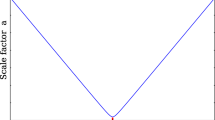Abstract
We discuss a new theory of the universe in which the vacuum energy is of classical origin and dominates the energy content of the universe. As usual, the Einstein equations determine the metric of the universe. However, the scale factor is controlled by total energy conservation in contrast to the practice in the Robertson–Walker formulation. This theory naturally leads to an explanation for the Big Bang and is not plagued by the horizon and cosmological constant problem. It naturally accommodates the notion of dark energy and proposes a possible explanation for dark matter. It leads to a dual description of the universe, which is reminiscent of the dual theory proposed by Milne in 1937. On the one hand one can describe the universe in terms of the original Einstein coordinates in which the universe is expanding, on the other hand one can describe it in terms of co-moving coordinates which feature in measurements. In the latter representation the universe looks stationary and the age of the universe appears constant. The paper describes the evolution of this universe. It starts out in a classical state with perfect symmetry and zero entropy. Due to the vacuum metric the effective energy density is infinite at the beginning, but diminishes rapidly. Once it reaches the Planck energy density of elementary particles, the formation of particles can commence. Because of the quantum nature of creation and annihilation processes spatial and temporal inhomogeneities appear in the matter distributions, resulting in residual proton (neutron) and electron densities. Hence, quantum uncertainty plays an essential role in the creation of a diversified complex universe with increasing entropy. It thus seems that quantum fluctuations play a role in cosmology similar to that of random mutations in biology. Other analogies to biological principles, such as recapitulation, are also discussed.
Similar content being viewed by others
References
Allen S. W. et al (2004) Constraints on dark energy from Chandra observations of the largest relaxed galaxy clusters. Monthly Notices of the Royal Astronomical Society: Letters 353: 457–467
Astier P. et al (2006) The supernova legacy survey: Measurement of Ω M , Ω E and w from the first year data set. Astronomy Astrophysics 447: 31–48
Bouwens R. J. et al (2006) Rapid evolution of the most luminous galaxies during the first 900 million years. Nature 443: 189
Carroll S. M. (2001) The cosmological constant. Living Review Relativity 4: 1–50
Carroll S. (2004) Spacetime and geometry. Addison Wesley, New York
Carroll S., Press W. H., Turner E. L. (1992) The cosmological constant. Annual Review of Astronomy and Astrophysics 30: 499–542
Casimir H. B. G. (1948) On the attraction between two perfectly conducting plates. Proceedings of the Koninklijke Nederlandse Akademie van Wetenschappen 51: 793–795
Copeland E. J., Sami M., Tsujikawa S. (2006) Dynamics of dark energy. International Journal of Modern Physics D15: 1753–1935
Freedman W. L. et al (2001) Final results from the Hubble space telescope key project to measure the Hubble constant. The Astrophysical Journal 553: 47–72
Fukugita M., Peebles P. J. E. (2004) The cosmic energy inventory. The Astrophysical Journal 616: 643–668
Gasser J., Leutwyler H. (1982) Quark masses. Physics Reports 87: 77–169
Gould S. J. (1977) Phylogeny and ontogeny. Harvard University Press, Cambridge
Haeckel E. (1992) The riddle of the universe. Prometheus Books, Buffalo, NY ISBN 0-87975-746-9
Hinshaw, G., et al. (2008). Five-year Wilkinson microwave anisotropy probe (WMAP1) observations: Data processing, sky maps, and basic results. Preprint. astro-ph/0803.0732.
Iye M. et al (2006) A galaxy at a red shift z = 6.96. Nature 443: 186–188
Jaffe R. L. (2005) Casimir effect and the quantum vacuum. Physical Review D 72: 021301, 1–5(R)
Krauss, L. M., & Starkman, G. D. (2007). Cosmic deconstructionism. Preprint. astro-ph/0702333v1.
Ledermann L. (2008) What we’ll find inside the atom. Newsweek 15: 39–44
McCrea W. H. (1951) A model universe admitting the interchangeability of stress and mass. Proceedings of the Royal Society of London. Series A 206: 562–575
McVittie G. C. (1965) General relativity and cosmology. Chapman and Hall, London
Milne E. A. (1937) Kinematics, dynamics, and the scale of time. Proceedings of the Royal Society of London. Series A 158: 324–348
Navarro J. F., Frenk C. S., White S. D. M. (1996) The structure of cold dark matter. The Astrophysical Journal 462: 563–575
Padmanabhan T. (2003) Cosmological constant: The weight of the vacuum. Physics Reports 380: 235–320
Prigogine I., Geheniau J. (1986) Entropy, matter, and cosmology. Proceedings of the National Academy of Sciences of the USA 83: 6245–6249
Rees M. (2002) Our cosmic habitat. Weidenfeld and Nicolson, London
Riess A. G. et al (2004) Type Ia supernova discoveries at z > 1 from the Hubble space telescope: Evidence for past deceleration and constraints on dark energy evolution. The Astrophysical Journal 607: 665–687
Riess A. G. et al (2005) Cepheid calibrations from the Hubble space telescope of the luminosity of two recent type Ia supernovae and a re-determination of the Hubble constant. The Astrophysical Journal 627: 579–607
Spergel D. N. et al (2003) First year Wilkinson microwave anisotropy probe (WMAP) observations: Determination of cosmological parameters. Astrophysical Journal 148: 175–232
Spergel, D. N., et al. (2006). Wilkinson microwave anisotropy probe (WMAP) three year results: Implications for cosmology. Preprint. astro-ph/0603449 v1.
Visser, M. (2003). Jerk, snap, and the cosmological equation of state. Preprint. gr-qc/0309109 v4.
Weinberg S. (1972) Gravitation and cosmology: Principles and application of the general theory of relativity. Wiley, New York
Weinberg S. (1989) The cosmological constant problem. Reviews of Modern Physics 61: 1–23
Author information
Authors and Affiliations
Corresponding author
Rights and permissions
About this article
Cite this article
Greben, J.M. The Role of Energy Conservation and Vacuum Energy in the Evolution of the Universe. Found Sci 15, 153–176 (2010). https://doi.org/10.1007/s10699-010-9172-0
Published:
Issue Date:
DOI: https://doi.org/10.1007/s10699-010-9172-0




